
Cucurbita is a genus of herbaceous vines in the gourd family, Cucurbitaceae, also known as cucurbits, native to the Andes and Mesoamerica. Five species are grown worldwide for their edible fruit, variously known as squash, pumpkin, or gourd depending on species, variety, and local parlance, and for their seeds. Other kinds of gourd, also called bottle-gourds, are native to Africa and belong to the genus Lagenaria, which is in the same family and subfamily as Cucurbita but in a different tribe. These other gourds are used as utensils or vessels, and their young fruits are eaten much like those of Cucurbita species.

Cucurbita pepo is a cultivated plant of the genus Cucurbita. It yields varieties of winter squash and pumpkin, but the most widespread varieties belong to the subspecies Cucurbita pepo subsp. pepo, called summer squash.
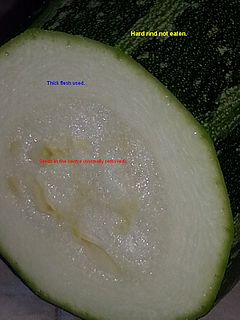
A marrow is a vegetable, the mature fruit of certain Cucurbita pepo cultivars. The immature fruit of the same or similar cultivars is called courgette or zucchini. Like courgettes, marrows are oblong, green squash, but marrows have a firm rind and a neutral flavour, making them useful as edible casings for mincemeat and other stuffings. They can be stored for several weeks after harvest, to be processed for food when required. They are a popular vegetable in Great Britain and areas with significant British influence, though their popularity is waning in favor of immature summer squash like courgette.
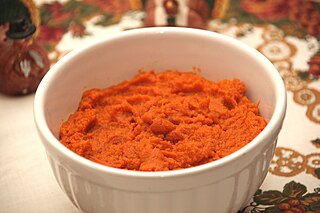
Mashed pumpkin is a vegetable dish made by cooking or macerating the skinless flesh (pulp) of pumpkins and then mashing, straining, grinding, or puréeing until the desired consistency is achieved. It is traditionally served as a side dish, although it has many uses in cooking and baking.

Green beans are the unripe, young fruit and protective pods of various cultivars of the common bean. Immature or young pods of the runner bean, yardlong bean, and hyacinth bean are used in a similar way. Green beans are known by many common names, including French beans, string beans, snap beans, snaps, and the French name French: haricots vert.

Tinda, also called "Indian squash", "round melon", "Indian round gourd" or "apple gourd" or "Indian baby pumpkin", is a squash-like cucurbit grown for its immature fruit, a vegetable especially popular in South Asia. It is the only member of the genus Praecitrullus. Tinda is also called "tindsi" in Rajasthan. In Marathi, it is called dhemase ढेमसे. in hindi and marathi also called "dilpasand" In Sindhi language, it is called meha.

Cucurbita ficifolia is a species of squash, grown for its edible seeds, fruit, and greens. It has many common names in English such as the fig-leaf gourd, Malabar gourd, black seed squash, and cidra. Although it is closely related to other squashes in its genus, such as the pumpkin, it shows considerable biochemical difference from them and does not hybridize readily with them.

Cucurbita moschata is a species originating in either Central America or northern South America. It includes cultivars known as squash or pumpkin. C. moschata cultivars are generally more tolerant of hot, humid weather than cultivars of C. maxima or C. pepo. They also generally display a greater resistance to disease and insects, especially to the squash vine borer. Commercially made pumpkin pie mix is most often made from varieties of C. moschata. The ancestral species of the genus Cucurbita were present in the Americas before the arrival of humans. Evolutionarily speaking the genus is relatively recent in origin as no species within the genus is genetically isolated from all the other species. C. moschata acts as the genetic bridge within the genus and is closest to the genus' progenitor.

Winter squash is an annual fruit representing several squash species within the genus Cucurbita. It differs from summer squash in that it is harvested and eaten in the mature fruit stage when the seeds within have matured fully and the skin has hardened into a tough rind. At this stage, most varieties of this fruit can be stored for use during the winter. Winter squash is generally cooked before being eaten, and the skin or rind is not usually eaten as it is with summer squash.
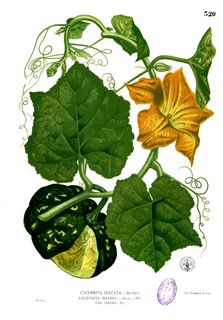
Cucurbita maxima, one of at least four species of cultivated squash, is one of the most diverse domesticated species. This species originated in South America from the wild Cucurbita andreana over 4000 years ago. The two species hybridize quite readily but have noticeably different calcium levels.

Amy Goldman Fowler is an American billionaire heir, gardener, author, artist, philanthropist, and advocate for seed saving and heirloom fruits and vegetables. She is one of the foremost heirloom plant conservationists in the US. Goldman is described as "perhaps the world's premier vegetable gardener" by Gregory Long, President of The New York Botanical Garden. On April 28, 2012, Goldman married Cary Fowler at the terrace on top of the Arsenal in Central Park.
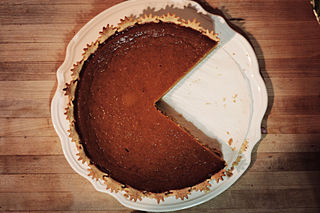
Pumpkin pie is a dessert pie with a spiced, pumpkin-based custard filling. The pumpkin is a symbol of harvest time, and pumpkin pie is often eaten during the fall and early winter. In the United States and Canada, it is usually prepared for Thanksgiving, and other occasions when pumpkin is in season.
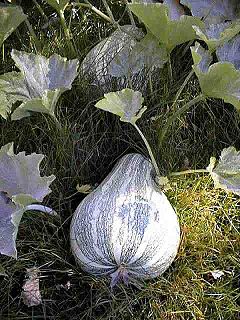
Cucurbita argyrosperma, also the Japanese pie pumpkin or cushaw pumpkin, and silver-seed gourd, is a species of winter squash originally from the south of Mexico. This annual herbaceous plant is cultivated in the Americas for its nutritional value: its flowers, shoots, and fruits are all harvested, but it is cultivated most of all for its seeds, which are used for sauces. It was formerly known as Cucurbita mixta.

Tromboncino, also known as zucchetta, is a type of squash most often used as a summer squash. While nearly all summer squash are cultivars of Cucurbita pepo, tromboncino is a cultivar of Cucurbita moschata. The vining growth habit is similar to many winter squashes, but unlike most other summer squash. It is more tolerant to some common summer squash pests, including squash vine borer, squash bugs, and powdery mildew, than the more commonly grown, bushy, C. pepo summer squash cultivars. The plants are slower to start producing than some C. pepo types. The fruit color is usually pale green, fading to beige upon maturity, and it is picked around one foot long for summer squash. It is an heirloom, originally from Liguria, and remains popular throughout Italy and abroad. Tromboncino squash can be left to mature into a winter squash; such is often compared to a watery butternut squash. If left to ripen, the fruits can grow over three feet in length.

Turban squash, also known as "Turk's turban" or "French turban", is a type of squash most often used as a winter squash. It is an heirloom, predating 1820. A cultivar of Cucurbita maxima, it is closely related to the buttercup squash. It is typically 6 pounds when mature. Colors vary, but are often mottled in shades of orange, green, and white. The squash is used as both a vegetable and as an ornamental gourd. Taste is similar to other C. maxima cultivars, though "not as vibrant," "reminiscent to hazelnut," and "coarse, watery and insipid." Known in the nineteenth century as "the most beautiful in color, and the most worthless in quality, of all the varieties of squash;" selective breeding since then may have improved the flavor.

Sarah Frey is an American farmer and business owner. She owns Frey Farms, the largest grower of pumpkins in the United States, and produces Tsamma juice, a bottled watermelon juice.




















